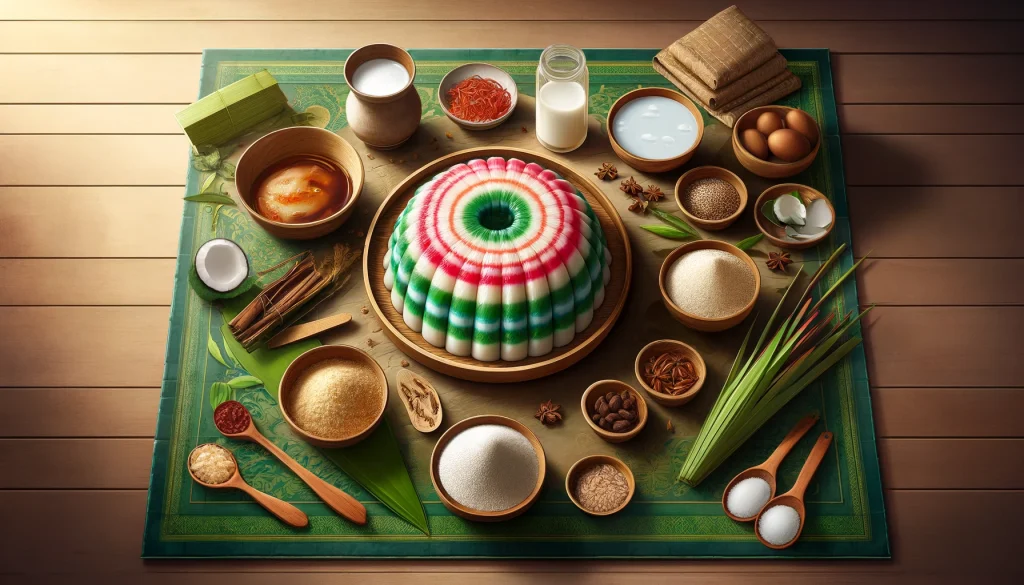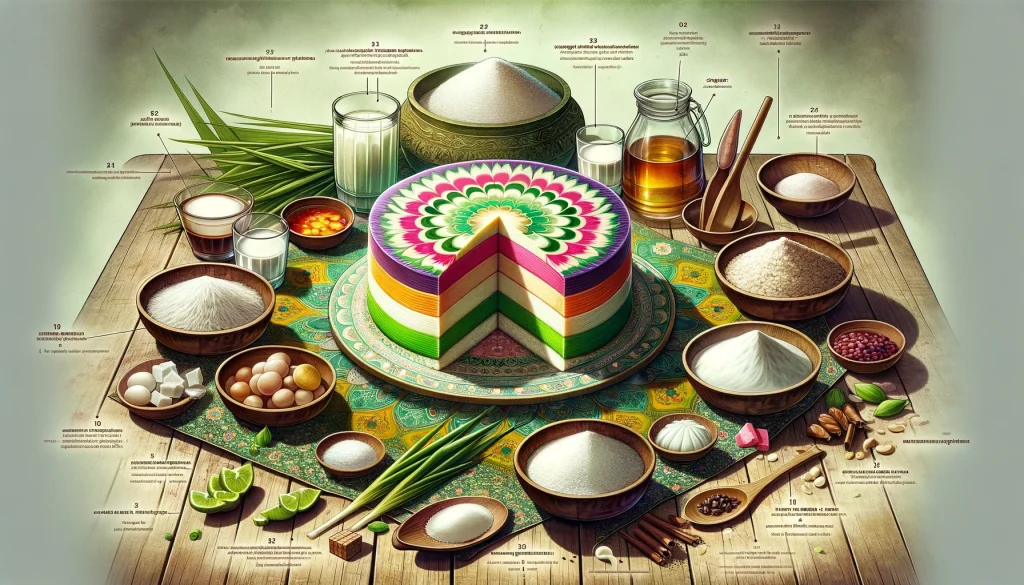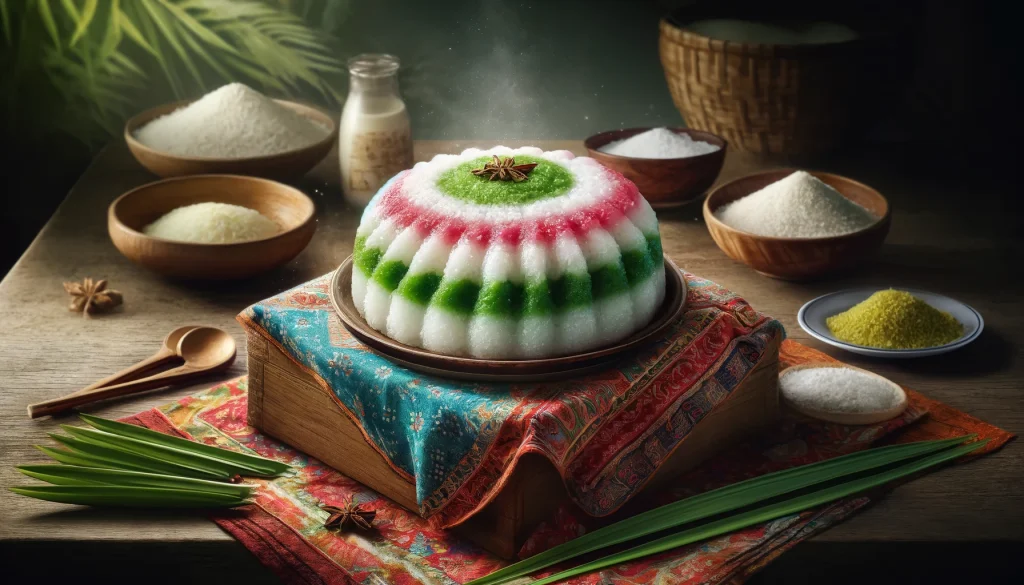As an Amazon Associate I earn from qualifying purchases.
Introducing a beloved delicacy from the vibrant tapestry of Malaysian cuisine: the Malaysian steamed rice cake, a culinary treasure steeped in tradition and flavor. Known for its delightful texture and aromatic profile, Malaysian steamed rice cakes are a staple in Malaysian households, often enjoyed as a snack, dessert, or part of celebratory feasts.
In this article, we embark on a culinary journey to explore the art of making Malaysian steamed rice cakes, with a focus on the iconic Kuih Serimuka. This traditional delicacy features layers of sticky glutinous rice topped with a fragrant pandan-infused custard, creating a harmonious blend of sweetness and richness.
Join us as we delve into the intricacies of crafting this beloved treat, from selecting the finest ingredients to mastering the techniques that yield the perfect texture and flavor. Whether you’re a seasoned cook eager to explore new recipes or a novice seeking to experience the richness of Malaysian cuisine, this article promises to inspire and guide you through the process of creating Malaysian steamed rice cakes in your own kitchen.
Get ready to savor the flavors of Malaysia and experience the joy of sharing this timeless delicacy with family and friends. Let’s embark on a culinary adventure filled with tradition, flavor, and the warmth of Malaysian hospitality.
Malaysian Steamed Rice Cake Recipe

Malaysian cuisine boasts a variety of steamed rice cakes, known for their unique textures and flavors. One popular variant is the Kuih Serimuka, a two-layered delight with a steamed glutinous rice bottom and a pandan-flavored custard top. Here’s how you can make this traditional treat at home.
Ingredients:
For the Glutinous Rice Layer:
- 2 cups glutinous rice, soaked for at least 4 hours or overnight
- 1 cup coconut milk
- 1/2 teaspoon salt
- 1 teaspoon sugar
- Pandan leaves (optional, for fragrance)
For the Pandan Custard Layer:
- 5 pandan leaves, chopped (or 2 teaspoons pandan extract for convenience)
- 1 cup coconut milk
- 2/3 cup sugar
- 2 tablespoons all-purpose flour
- 2 tablespoons cornstarch
- 4 large eggs
- A pinch of salt
Instructions:
Preparing the Glutinous Rice:
- Drain the soaked glutinous rice and spread it in a steaming tray lined with pandan leaves (if using).
- Mix coconut milk, salt, and sugar in a bowl. Pour this mixture over the glutinous rice and gently stir to evenly coat.
- Steam the rice for 20-30 minutes, or until fully cooked. Halfway through steaming, fluff the rice to ensure even cooking. Once cooked, compact the rice into an even layer at the bottom of your mold or tray.
Preparing the Pandan Custard Layer:
- Blend the pandan leaves with 1/2 cup of coconut milk, then strain to get pandan juice. Skip this step if you’re using pandan extract.
- Mix the pandan juice or extract with the rest of the coconut milk, sugar, flour, cornstarch, eggs, and a pinch of salt. Strain the mixture to ensure it’s smooth.
- Cook this mixture over low heat until it thickens slightly, stirring constantly to prevent lumps.
- Pour the semi-cooked custard over the cooked glutinous rice layer, then continue to steam everything for another 30 minutes or until the custard layer is set.
Serving:
- Cool the Kuih Serimuka completely before cutting it into pieces, as it will firm up and be easier to cut.
- Serve at room temperature or slightly chilled.
Enjoy the delightful texture contrast between the creamy pandan custard and the chewy glutinous rice layer in this traditional Malaysian delicacy.
Expert Tips
Creating the perfect Malaysian steamed rice cake, such as Kuih Serimuka, involves a blend of technique, tradition, and a touch of personal flair. Here are expert tips to elevate your rice cake to the next level:
1. Quality of Ingredients:
- Pandan Leaves: Fresh pandan leaves are preferable for the most aromatic flavor. If unavailable, high-quality pandan extract is a good substitute, but the aroma and taste might slightly differ.
- Glutinous Rice: Opt for high-quality, fresh glutinous rice for the best texture. Old rice can be dryer and less sticky.
- Coconut Milk: Use fresh or canned coconut milk with a high percentage of coconut extract for the creamiest texture and richest flavor.
2. Soaking the Rice:
- Soak the glutinous rice for at least 4 hours, or overnight if possible. This step is crucial for achieving the right texture, as it ensures the rice cooks evenly and becomes perfectly sticky.
3. Steaming Techniques:
- Even Layering: When spreading the rice in the steaming tray, ensure it’s in an even layer for uniform cooking. A compact layer forms a good base for the custard.
- Pandan Leaves: Steaming the rice on a bed of pandan leaves infuses it with a delightful fragrance. This traditional method adds depth to the dish’s flavor profile.
- Steam Management: Ensure the steamer is well-sealed during cooking. Excess steam can condense and drip onto the cake, affecting the texture. Cover the lid with a cloth to absorb condensation if necessary.
4. Preparing the Pandan Custard Layer:
- Smoothness: To achieve a smooth, lump-free custard layer, thoroughly strain the pandan mixture. Any fibrous parts or lumps can affect the final texture.
- Cooking the Custard: Gently cook the custard mixture before pouring it over the rice layer. This pre-cooking process helps to thicken the custard, ensuring it sets properly without seeping into the rice layer.
5. Cooling and Cutting:
- Cooling: Allow the cake to cool completely at room temperature before cutting. This patience is rewarded with cleaner cuts and a firmer texture.
- Knife: Use a plastic knife or a knife dipped in water to cut the cake. This prevents sticking and ensures smooth, clean slices.
6. Flavor Adjustments:
- Personalize the sweetness or the intensity of the pandan flavor according to your taste. Adjusting these elements can make the recipe more suited to your preferences.
7. Serving:
- Kuih Serimuka can be enjoyed at room temperature or slightly chilled. Serving it chilled can further firm up the texture, making it even more refreshing.
By following these expert tips, you’ll not only honor the tradition behind Malaysian steamed rice cakes but also master the nuances that make this dessert truly special. Whether you’re a seasoned cook or a culinary novice, these insights will help you bring a piece of Malaysian heritage into your kitchen.
Why This Recipe Is Just So Good…

This Malaysian steamed rice cake recipe, particularly the Kuih Serimuka variant, offers a combination of delightful flavors, textures, and cultural heritage that make it truly special. Here’s why this recipe is so good:
1. Flavor Harmony:
- The blend of fragrant pandan-infused custard with the subtly sweet, sticky glutinous rice creates a harmonious balance of flavors that is both comforting and satisfying.
- The natural sweetness from coconut milk complements the earthy tones of the pandan, resulting in a nuanced flavor profile that appeals to a wide range of palates.
2. Textural Contrast:
- The soft, creamy custard layer contrasts beautifully with the chewy, slightly sticky glutinous rice layer, creating a textural experience that is both interesting and enjoyable.
- Each bite offers a delightful interplay between the smoothness of the custard and the toothsome bite of the rice, making it a pleasure to eat.
3. Cultural Significance:
- This recipe is deeply rooted in Malaysian culinary heritage, reflecting the rich tapestry of flavors and traditions that define Malaysian cuisine.
- Making and sharing Kuih Serimuka is often associated with festive occasions and family gatherings, adding a sense of warmth and nostalgia to the dining experience.
4. Versatility:
- While traditionally served as a dessert or snack, Kuih Serimuka can also be enjoyed as a breakfast treat or afternoon delight.
- Its versatility allows for creative adaptations and variations, making it suitable for different occasions and preferences.
5. Homemade Charm:
- Making Kuih Serimuka from scratch allows you to infuse the recipe with your own personal touch and creativity, adding to the overall appeal of the dish.
- The satisfaction of creating something delicious and culturally significant from simple, wholesome ingredients adds to the enjoyment of the eating experience.
In summary, this Malaysian steamed rice cake recipe is more than just a culinary delight – it’s a celebration of flavors, textures, and traditions that come together to create a truly unforgettable dining experience. Whether enjoyed on special occasions or as a simple indulgence, Kuih Serimuka embodies the essence of Malaysian hospitality and culinary craftsmanship.
Storage Instructions
Proper storage is essential to maintain the freshness and quality of Malaysian steamed rice cakes like Kuih Serimuka. Here are some storage instructions:
Short-Term Storage:
- Room Temperature: If planning to consume within 1-2 days, store the rice cake at room temperature in an airtight container or wrapped tightly in plastic wrap. Keep it away from direct sunlight and heat sources to prevent drying out.
Long-Term Storage:
- Refrigeration: For longer storage, place the rice cake in an airtight container or wrap it tightly in plastic wrap and store it in the refrigerator. It can last for up to 4-5 days when refrigerated. Allow it to come to room temperature before serving for the best texture and flavor.
Freezing:
- For Extended Storage: Malaysian steamed rice cakes can be frozen for up to 1-2 months. Wrap individual portions tightly in plastic wrap, then place them in a freezer-safe container or resealable plastic bag to prevent freezer burn.
- Thawing: When ready to enjoy, thaw the frozen rice cake in the refrigerator overnight. Alternatively, you can microwave it on low power for short intervals until thawed, but be cautious not to overheat and compromise the texture.
Additional Tips:
- Avoid Moisture: Ensure the rice cake is completely cooled before storing it to prevent condensation, which can make it soggy.
- Layering: If stacking multiple pieces of rice cake, place parchment paper or plastic wrap between each layer to prevent sticking.
- Freshness Check: Before consuming refrigerated or frozen rice cake, check for any signs of spoilage, such as off odors or unusual texture changes.
By following these storage instructions, you can prolong the shelf life of Malaysian steamed rice cakes while maintaining their delicious taste and texture for future enjoyment.
Frequently Asked Questions (FAQ)

Here are some expertise-level questions and answers regarding the Malaysian steamed rice cake recipe:
Q: What is Malaysian steamed rice cake?
A: Malaysian steamed rice cake refers to a variety of traditional Malaysian kuih (cakes) that are steamed instead of baked. A popular example is Kuih Serimuka, which has a layer of glutinous rice and a green pandan custard layer on top.
Q: What makes the rice layer in Kuih Serimuka sticky?
A: The stickiness comes from using glutinous rice, also known as sticky rice. The rice is soaked for hours and then cooked with coconut milk, which adds to its creamy texture and stickiness.
Q: How do I get the pandan flavor for the custard layer?
A: The pandan flavor is typically obtained by blending fresh pandan leaves with a bit of water to create a pandan extract. This extract is then strained and added to the custard mixture. If fresh pandan leaves are not available, pandan essence or paste can be used as an alternative.
Q: Can I use regular rice instead of glutinous rice?
A: No, regular rice will not yield the same sticky, chewy texture that is characteristic of Kuih Serimuka. Glutinous rice is essential for achieving the correct consistency and mouthfeel.
Q: Why does my custard layer sometimes become lumpy or curdled?
A: Lumps or curdling can occur if the custard is cooked at too high a temperature or if the eggs in the custard begin to scramble. To prevent this, cook the custard over a gentle heat, stirring constantly, and consider straining the mixture before steaming to remove any lumps.
Q: How can I ensure my steamed rice cake comes out of the mold easily?
A: Greasing the mold lightly with a bit of oil or lining it with banana leaves can help the rice cake release more easily after steaming. Allow the cake to cool slightly before attempting to unmold it, as it will firm up and be less likely to break apart.
Q: Can Malaysian steamed rice cake be made vegan?
A: Yes, it can be made vegan by ensuring no animal products are used. For Kuih Serimuka, use plant-based coloring for the green layer instead of pandan leaves if necessary, and ensure the coconut milk is free from any animal-derived additives.
Q: How long can I store Malaysian steamed rice cakes?
A: They are best enjoyed fresh but can be stored in an airtight container in the refrigerator for up to 3-4 days. For longer storage, they can be frozen and then reheated, although the texture might slightly change upon thawing.
Q: Is there a quick method for making Malaysian steamed rice cake?
A: While traditional recipes prioritize slow and careful preparation, certain steps can be simplified with modern kitchen appliances. For example, a blender can expedite the process of making pandan extract, and a rice cooker can be used to cook the glutinous rice, although the unique steamed texture might be slightly altered.
Q: Can I add other flavors to the rice cake?
A: Absolutely! While pandan is traditional, the recipe is versatile. Feel free to experiment with other flavors like durian, mango, or even chocolate for the custard layer. Just ensure the additional flavors complement the creamy texture and sweetness of the cake.
Q: What role does pandan play in Malaysian steamed rice cake recipes like Kuih Serimuka?
A: Pandan, a fragrant tropical leaf commonly used in Malaysian cuisine, adds a unique aroma and flavor to steamed rice cakes like Kuih Serimuka. It infuses the custard layer with a subtle, earthy sweetness, enhancing the overall taste and fragrance of the dish.
Q: How can one achieve the perfect balance between the custard and glutinous rice layers in Kuih Serimuka?
A: Achieving the ideal balance between the custard and glutinous rice layers involves careful attention to texture and flavor. The glutinous rice layer should be sticky and slightly chewy, providing a sturdy base for the creamy custard layer. Adjusting the thickness and sweetness of the custard to complement the rice layer is key to achieving harmonious layers.
Q: What techniques can be employed to prevent the custard layer from becoming lumpy during cooking?
A: To ensure a smooth and lump-free custard layer, it’s essential to strain the pandan mixture thoroughly before combining it with the other custard ingredients. Additionally, cook the custard mixture over low heat and stir constantly to prevent the formation of lumps. Straining the custard mixture again before pouring it over the rice layer can further ensure a silky smooth texture.
Q: How does the choice of coconut milk impact the flavor and texture of Malaysian steamed rice cakes?
A: Coconut milk is a key ingredient in Malaysian steamed rice cakes, contributing to both the flavor and texture of the dish. High-quality coconut milk with a high percentage of coconut extract yields a richer, creamier texture and imparts a more pronounced coconut flavor to the rice cakes. Using fresh coconut milk or reputable canned coconut milk brands ensures the best results.
Q: Can the traditional recipe for Malaysian steamed rice cakes be modified to accommodate dietary restrictions or preferences?
A: Yes, the traditional recipe for Malaysian steamed rice cakes can be adapted to suit various dietary preferences and restrictions. For example, substitutions can be made to accommodate lactose intolerance or vegan diets by using alternative plant-based milk options. Similarly, adjustments can be made to the sweetness level or flavorings to suit individual preferences without compromising the integrity of the dish.
Q: What cultural significance do Malaysian steamed rice cakes hold in Malaysian culinary traditions?
A: Malaysian steamed rice cakes, such as Kuih Serimuka, hold significant cultural importance in Malaysian culinary traditions. They are often served during festive occasions, religious celebrations, and family gatherings, symbolizing prosperity, unity, and the sharing of blessings. These rice cakes are deeply ingrained in Malaysian heritage, reflecting the diverse cultural influences and culinary heritage of the country.
These expertise-level questions and answers provide valuable insights into the intricacies of making Malaysian steamed rice cakes, offering guidance for achieving the perfect balance of flavors, textures, and cultural significance in this beloved dish.
Conclusion
In conclusion, the Malaysian steamed rice cake recipe, exemplified by the delightful Kuih Serimuka, offers a delightful fusion of flavors, textures, and cultural heritage. Through the harmonious marriage of fragrant pandan-infused custard and sticky glutinous rice, this traditional delicacy captures the essence of Malaysian cuisine and culinary craftsmanship.
As we wrap up our culinary journey, it’s evident that Malaysian steamed rice cakes hold a special place in the hearts and homes of Malaysians, symbolizing joy, celebration, and togetherness. Whether enjoyed during festive occasions, family gatherings, or simple moments of indulgence, Kuih Serimuka embodies the warmth and hospitality of Malaysian culture.
By mastering the art of making Malaysian steamed rice cakes at home, we not only honor the rich culinary heritage of Malaysia but also create cherished memories and experiences to be shared with loved ones. So, let us continue to embrace the flavors, traditions, and joys of Malaysian cuisine, one delicious bite of Kuih Serimuka at a time.






